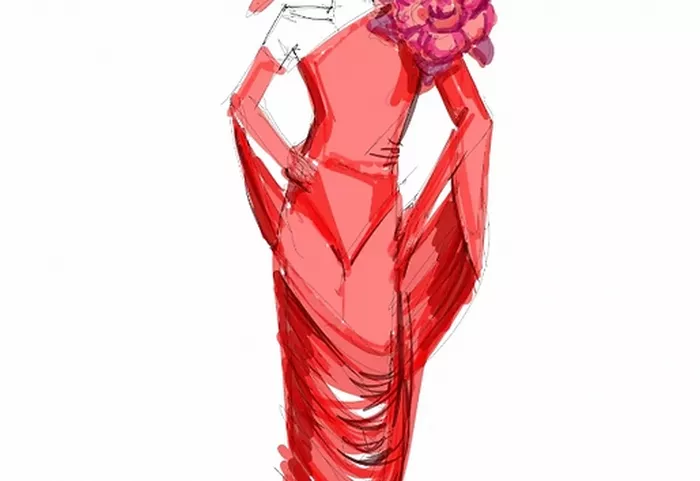London College of Fashion alumnus Robert Wun has taken the fashion world by storm since founding his eponymous brand in 2014. This year, Wun unveils his debut haute couture collection at Paris Fashion Week. His Fall/Winter 2024 collection, titled Time, marks a monumental milestone—celebrating his ten-year anniversary in fashion. This collection delves deeply into the concept of time and its inevitable effects on our transient world, blending elements of nature, human anatomy, and Asian philosophy.
Drawing inspiration from the cyclical patterns of life, Wun’s designs are a powerful tribute to both nature and the human experience. Through motifs such as cherry blossoms and butterflies, he explores themes of impermanence, decay, and the beauty found in the imperfect. These symbols, rooted in Asian philosophy, lend a unique perspective to haute couture.
The first look in the collection serves as a representation of winter and the first snowfall. A black gown adorned with white specks mimics falling snow, while a draped piece of fabric over the model’s face and bodice directs attention to the stark contrast between the black and white. This opening look sets the tone for the collection, capturing winter’s somber beauty and emphasizing the beauty found in imperfection. The scattered snow symbolizes the fleeting nature of beauty, reinforcing Wun’s thematic exploration of life’s transient moments.
As the collection progresses, spring emerges with a brighter color palette that symbolizes the renewal of life. Drawing from his Hong Kong roots, Wun uses cherry blossoms to honor his Asian heritage. In Chinese culture, flowers represent the ephemeral nature of life, embodying both beauty and the inevitability of death. The use of dark silhouettes juxtaposed with vibrant cherry blossoms captures this theme, allowing the beauty of spring to come to life on the runway.
Summer is introduced with fiery hues of red, yellow, and orange, evoking the warmth of the sun. A standout piece from this section is a fiery red gown adorned with a delicate flower on the left shoulder. The red base fascinator partially obscures the model’s face, adding an air of mystery. The fluttering butterfly motif returns here, symbolizing transformation and new beginnings, much like the sun’s rays that usher in the vibrant energy of summer.
Autumn follows with a shift in colors, representing the decay and fading of the season. Wun embraces the concept of decay, highlighting the beauty in transience. One striking example is a black gown adorned with vibrant red and orange butterflies along the train, paired with a coat deliberately distressed to evoke the idea of decay. The butterfly motif persists, representing the duality of life’s cycles—life and death, growth and decay.
In this segment, Wun introduces the Japanese philosophy of Kintsugi, which celebrates the art of mending broken objects with gold. This philosophy is reflected in the design of a shredded black bodice, “mended” with beautiful white tulle, emphasizing the beauty of imperfection. This technique extends to a headpiece, which symbolizes the idea that, while broken, objects and people alike can still hold immense beauty in their flaws.
Wun shifts the focus to the human body in the latter half of the collection, stripping away the physical layers to reveal the deeper, spiritual core of the human form. The “skin” is represented through pleated, flesh-toned fabrics like chiffon and silk, draped vertically to convey the movement and flow of the body. This design highlights the interplay between the physical and the intangible, allowing the human form to come to life in a completely new way.
A deep red gown, inspired by the muscular structure of the human body, follows. The bodice is sculpted with varying shades of crimson, contouring the model’s figure to mimic muscle structure. The gown’s train, embroidered with intricate bugle beads, captures the fluidity of muscle, depth, and movement. This piece speaks to the physical complexity and elegance of the human form.
The final look in the show takes an ethereal turn, drawing parallels between the human soul and the cosmos. The gown, covered in crystal embroidery, depicts a cosmic galaxy with shades of midnight blue, pink, light blue, purple, and amber, embodying the soul’s connection to the universe. This look is a beautiful manifestation of the Taoist philosophy of Ch’i, the vital energy that harmonizes all living things with the universe. The model’s face is obscured by a translucent sheath adorned with golden crystals, reinforcing the idea that the soul is the essence of a person, rather than their physical form.
Wun’s Fall 2024 haute couture collection encapsulates the passage of time through nature’s cycles and human anatomy. The use of color transitions—from the vibrant hues of spring and summer to the muted tones of autumn and winter—mirrors the natural progression of life. At the same time, the stripping away of anatomical layers emphasizes the deeper significance of the human soul, which remains constant despite life’s inevitable changes.
The collection reflects Wun’s brilliance as a designer, as he artfully combines Asian philosophy with haute couture craftsmanship to create a collection that celebrates both beauty and imperfection. Through intricate details and profound thematic concepts, Wun continues to push the boundaries of fashion, reminding us of the fleeting yet beautiful nature of existence.
Related Topics
- Todd Snyder to Return to the Runway at New York Fashion Week
- Love Island All Stars 2025: Stylish Men’s Shirts Steal the Show as New Season Kicks Off
- Francis Libiran Opens Harbin Fashion Week 2025

